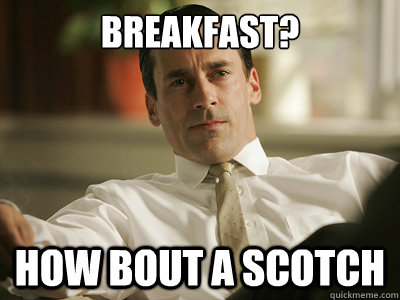The Don Draper School of Charisma: How to Make Your Business Charm Customers

Is your product or service positively charming?
Not sure?
Well get comfortable, pour yourself an Old Fashioned, and get ready to charm your customers like Don Draper.
It’s simpler than you might think. But it can be a little scary; you have to shatter any illusions of perfection and show customers they’re dealing with a human.
What a Train Wreck of a Character Can Teach You About Charm
Even if you don’t watch the TV show Mad Men, you’re probably familiar with Don Draper. He’s one of the most charismatic characters on television right now. And in a cast full of engaging personalities, he stands out above the rest.
Why’s he so memorable?
He’s a creative director at a fictional advertising agency on Madison Avenue. But that’s the boring part. What’s more interesting is Draper’s mysterious past, endless line of lovers, and penchant to get drunk and take two-hour naps in the middle of the workday.
His character is incredibly complex. Watching him is watching a living, breathing train wreck. But when it’s time to pitch an important client or deliver on a big idea, he pulls himself together and comes through… charming the pants off everyone around him in the process.
How is he able to do this? Why is this disaster of a man so effective in getting people to buy in to his ideas and do what he wants? Let’s take a look at how he does this. You’ll find out Draper’s secret and how you can apply it to charm more customers…
Wait. Isn’t Don Draper Just an Angry, Binge-Drinking, Chain-Smoking Bully?

Don’s pretty much an asshole 95% of the time.
Each episode of Mad Men peels another layer of Draper’s complex personality. But most of the time, he’s walking through the office with a scowl on his face. It’s his way or the highway. He intimidates coworkers into doing what he wants, and he doesn’t indulge small talk or stupidity.
Draper is a sealed book. He keeps his personal life shut off from work, interacting with coworkers to the extent his job forces him to. Don isn’t close with any of his colleagues, but they all respect him. They recognize his creative talents, cool confidence, and ability to come through in clutch situations.
But that isn’t the end of the story…
Don Draper’s Secret “Charisma Sauce:” Selective Vulnerability
The Mad Men writers do a great job of making Draper’s character walk the line between someone you love to hate and someone you root for.
Draper is polished and careful with his secrets, but it’s only a matter of time before the flaws come out… sometimes with disastrous effect.
That’s the secret to Don Draper’s charisma. There’s a balance between cool confidence and vulnerability. And that vulnerability makes him complex, likable, and real. He isn’t just an archetypal, sociopathic business tycoon.
You never know “which” Don you’re going to get. His vulnerability shows other characters that he’s actually a human instead of a robot walking around in a sharp suit. It makes him relatable and adds to his charm.
Take a look at how this vulnerability surfaces in one of my all-time favorite scenes: Don’s pitch to Kodak…
His delivery is confident, but it isn’t mechanical. Real emotion comes through in the delivery. Regret, nostalgia, and a subtle sense of hope for the future. Don doesn’t try to hide it. Instead, he embraces this vulnerability and uses it to turn a good pitch into a great pitch.
Why Presenting a Perfect Image is Dangerous
You can take a page out of Don Draper’s playbook. And you should. If you don’t, there could be consequences.
Consumer cynicism and skepticism are at all-time highs. People won’t give you the benefit of the doubt. They won’t “believe you until you prove them wrong.”
In the eyes of today’s consumer, you’re guilty until proven innocent. When you use your web copy to puff up your chest and convey an image of perfection, people flat out won’t believe you.
Whitewashing your product or service – making it sound like the cure to cancer, world hunger, and AIDS all in one – will only lead to doubt and questions.
Questions like:
“What’s this guy (or gal) hiding?”
“Why do they sound so desperate for me to buy this right now?”
These questions poke holes in your sales process. They ruin momentum, add friction, and cost you sales.
The Solution: Freely Admitting Your Flaws

Even if what you’re selling is awesome (and I’m sure it is), it isn’t perfect for everyone. Pretending that it is – and presenting it that way to potential customers – only deludes yourself. Customers see right through it.
It doesn’t matter if you design a Mercedes or Rolex equivalent in your niche. Some people will find things they don’t like, and won’t hesitate to point them out.
So, how do you present that perfect, Don Draper combination of a polished, compelling image and real human vulnerability?
By not being afraid to admit your product or service isn’t perfect. By stop lying through your teeth that your product is the best choice for everyone in every situation.
Don’t be afraid of your flaws. Seeing them for what they are – peering through the microscope and studying all of your diamond’s imperfections – lets you make your offer unique. Expressing them gives your product character. And it offers prospects reassurance that they’re dealing with someone real instead of a faceless online scammer.
Freely admitting your minor flaws is a copywriting principle that goes back to the direct response wizards of old. Here’s what copywriting legend David Ogilvy had to say about it:
The antique dealer who points out a scratch before he lets me buy his chair always wins my trust for life.
Framing Flaws on Your Terms Boosts Credibility and Shows People You’re Human
So your product or service has a few weaknesses?
So what?
People will trust you more if you put your cards on the table. Let your hair down and show them you’re real. You’ll attract a better set of prospects because they’ll have the chance to do an honest assessment of your product’s strengths and weaknesses, and see that they’re a good fit.
Think of the infamous interview question:
What are your biggest weaknesses?
“I work too hard,” “I’m a perfectionist,” and other standard answers drip with insincerity. No one buyers them because they aren’t real.
Don’t do this. If your product or service isn’t the cheapest option on the block, don’t give people a cheesy stock answer why it isn’t. Give your reasoning, but don’t shy away from the fact that you’re a premium option. Don’t make excuses and embrace potential weaknesses, and you’ll turn them into selling points.
People want to do business with real, honest people. Not faceless online operations that use stock photos and stock copy to create a farce of “perfection.”
Is there any baggage you’re holding onto? Are you showing people your true colors?
What Are You Holding Back? (Stop Now!)
We can’t all be as charming as Don Draper, but we can present our products and services to prospects in a more charismatic way.
You’re polished and confident, yeah? Combining that with a little selective vulnerability – letting people see your soft spots – is a great way to relate to customers, boost your credibility, and convince people to buy from you.
What lumps are you hiding?
Your customers will sniff them out sooner or later. And they won’t be happy when they do. You’re better off being proactive and framing weaknesses on your terms.
In a space full of scammers and fly-by-night operations, your customers will appreciate a little human candor.
Are you holding anything back from your prospects because you’re afraid of scaring them away? What’s one thing you could be more upfront about?
Leave a comment and share an example. Bonus points if you share your favorite classic cocktail! (mine’s a Manhattan).